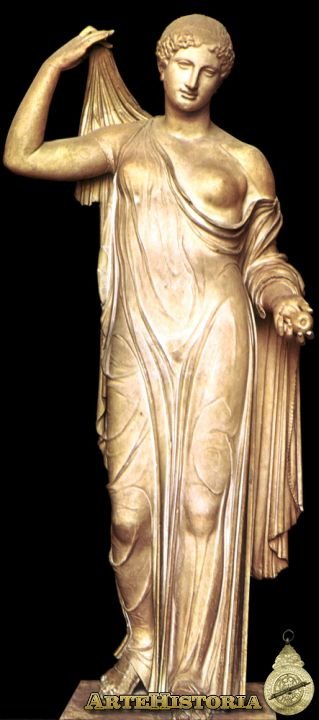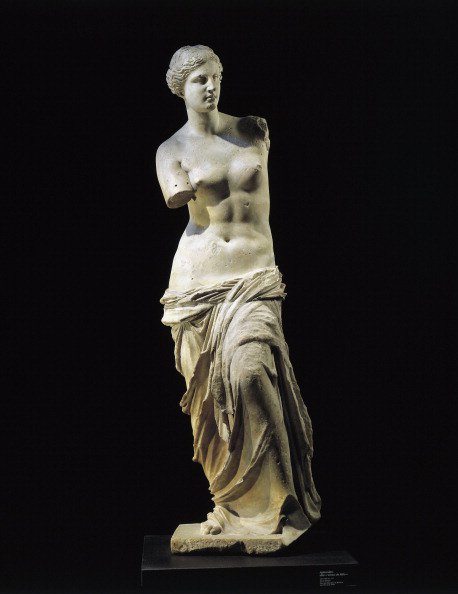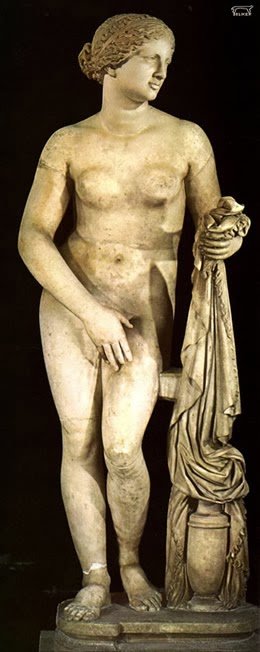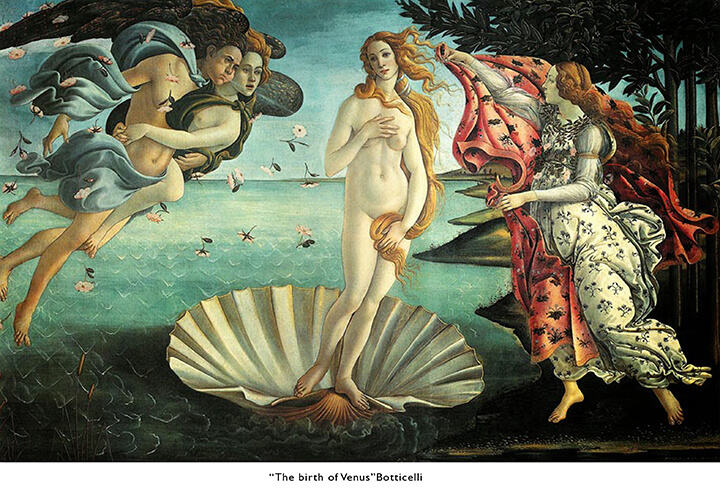[ESP/ENG] Un Tributo a Venus y su metamorfosis hasta la era contemporánea/A Venus' Tribute and her metamorphosis till the contemporary age

¿Qué repercusiones ha tenido la imagen de Venus sobre nuestra concepción acerca del amor y el origen de la vida?... O más bien, ¿ha sido al revés?
Desde los albores de la civilización, el hombre ha personificado sobre el ideal femenino, poderes como el de la fertilidad, la fuerza de la naturaleza, el amor, el erotismo y la sensualidad. Origen de encuentros y desencuentros, apreciar la metamorfosis de Venus a través de la historia, es comprender como ha evolucionado la visión del hombre hasta nuestros tiempos.
La figura de Venus así como los cánones de belleza no han sido más que el reflejo del contexto histórico que vivían las sociedades para el momento de su concepción.
Así es como nos encontramos a una de las Venus más emblemáticas como lo es, la de Willendorf, esta escultura que data desde el periodo Gravetiense (28.000 y 25.000 a. C.), hallada en Austria en 1908 (para el momento de su descubrimiento, en territorio del Imperio Austrohúngaro), constituida con unos exaltados rasgos sexuales, como lo son sus grandes pechos, prominentes caderas y una acentuada obesidad. Símbolos para la época, de salud, fertilidad y fecundidad, rasgos de difícil hallazgo en una sociedad primitiva.

What repercussions has the image of Venus had on our conception of love and the origin of life? Or rather, has it been the other way around?
Since the dawn of civilization, man has personified the feminine ideal, powers such as fertility, the force of nature, love, eroticism and sensuality. Origin of encounters and disagreements, to appreciate the metamorphosis of Venus through history, is to understand how the vision of man has evolved up to our times.
The figure of Venus as well as the canons of beauty have not been more than the reflection of the historical context that the societies lived for the moment of their conception.
This is how we find one of the most iconic Venus, such as Willendorf, this sculpture dating from the Gravettian period (28,000 and 25,000 BC.), found in Austria in 1908 (at the time of its discovery, in the territory of the Austro-Hungarian Empire), constituted with exalted sexual features, such as its large breasts, prominent hips and a marked obesity. Symbols for the time, health, fertility and fecundity, traits of difficult finding in a primitive society.
Durante el periodo clásico, los estándares de belleza se sometieron a una transformación. Quién para los griegos sería Afrodita, para los romanos sería Venus, perteneciente al clan de la docena de dioses que vivían con Zeus en el Olimpo.
La representación de estas diosas, se iría estilizando predominando así un carácter de simetría y armonía en sus proporciones y facciones.
En sus inicios Afrodita sería representada vestida, elemento que podemos apreciar en la Afrodita de Urania atribuida a Fidias.

During the classic period, beauty standards underwent a transformation. Who for the Romans would be Venus, for the Greeks it would be Aphrodite, belonging to the clan of the dozen gods who lived with Zeus on Olympus.
The representation of these goddesses, would be styled thus prevailing a character of symmetry and harmony in their proportions and features.
In its beginnings Aphrodite would be represented dressed, element that we can appreciate in the Aphrodite of Urania attributed to Fidias.
Para el año 400 a.C Afrodita sería nuevamente representada sobre mármol por Kallimacho, en la Afrodita de Frejus, cubierta por un manto suelto translucido de chitón, que sostiene cayendo sobre su espalda, dejando uno de sus pechos al descubierto. Dando así comienzo a la desnudez.

For the year 400 BC, Aphrodite would be again represented on marble by Kallimacho, in the Aphrodite of Frejus, covered by a loose translucent mantle of chiton, which she keeps falling on her back, leaving one of her breasts exposed. Giving thus beginning to the nudity.
Mas adelante entre los años 130 y 100 a.C sería creada por un autor desconocido (Se presume que Alejandro de Antioquía) una de las obras más representativas y emblemáticas de la antigua Grecia y el periodo Helenístico, la Venus de Milo, hallada en la Isla de Milo, en el año 1820, plasmada dejando caer una túnica sobre sus caderas, provocando un contraste entre la desnudez de su torso y los pliegues que cubren sus muslos, en un estado de semidesnudez.

Later between the years 130 and 100 BC it would be created by an unknown author (Alexander of Antioch is presumed) one of the most representative and emblematic works of ancient Greece and the Hellenistic period, the Venus de Milo, found on the Island of Milo, in the year 1820, captured by dropping a tunic over her hips, causing a contrast between the nudity of her torso and the folds that cover her thighs, in a state of half-nakedness.
Dos de las grandes curiosidades entorno a esta obra serían la ausencia de sus brazos. Se especula se encontraron restos de ellos en su lugar de hallazgo, y la pérdida de adornos propios de la estatua (Una diadema, pulsera y pendientes) de los cuales aún conserva sus anclajes.
Two of the great curiosities around this work would be the absence of his arms. It is speculated that remains of them were found in their place of discovery, and the loss of own ornaments of the statue (A diadem, bracelet and earrings) of which still retains its anchors.
Praxiteles sería en el año 360 a.C el autor de una de las más famosas representaciones de esta diosa en la antigua Grecia, la Afrodita de Cnidos, sucedida en este honor por la afrodita de Frejus, siendo esta personificación un reflejo de amor erótico en oposición a la Afrodita Urania, por ello se presenta desnuda, previa o posterior a realizar el baño de las heulasias, dejando caer ligeramente sus atavíos sobre una ánfora, mientras cubre incompletamente su pubis, como si hubiese sido sorprendida en su faena.

Praxiteles would be in 360 BC the author of one of the most famous representations of this goddess in ancient Greece, the Aphrodite of Cnidos, succeeded in this honor by the Aphrodite of Frejus, this personification being a reflection of erotic love in opposition to the Aphrodite Urania, therefore she appears nude, before or after bathing the heulaias, letting her trappings fall lightly on an amphora, while incompletely covering her pubis, as if she had been surprised at her task.
10 siglos más tarde se consagraría Boticcelli con una de sus mayores obras, El nacimiento de Venus, ilustrando nuevamente su cuerpo desnudo para el cual realizaría arduos estudios anatómicos.

10 centuries later Boticcelli would consecrate himself with one of his greatest works, The Birth of Venus , again illustrating his naked body for which he would perform arduous anatomical studies.
Así volverían con el Renacimiento, a los antiguos conceptos clásicos griegos y romanos, con un hombre apartado de los principios religiosos, para adquirir mayor entendimiento sobre el como una criatura influyente sobre su entorno.
Desde ese momento hasta la actualidad se irían normalizando cada vez mas las representaciones desnudas femeninas.
Para el siglo XXI abundaron más que nunca los desnudos, debido a la creciente oleada de liberación sexual que se vería a partir de los años 60. En el séptimo arte se han hecho infinidades de referencias y guiños a esta icónica figura, tal es el caso de la cinta “The Dreamers" de Bertolucci, estrenada en el año 2003, donde se puede apreciar una más que clara referencia a Venus de Milo, pues en una de sus escenas podemos observar a la actriz francesa Eva Green posar como la figura deísta.

So they would go back to the Renaissance, to ancient Greek and Roman classical concepts, with a man cut off from religious principles, to gain more understanding of him as an influential creature on his environment.
From that moment to the present, the naked female representations would be normalized more and more.
For the 21st century nudes abound more than ever, due to the growing wave of sexual liberation that would be seen from the 60s. In the seventh art there have been infinite references and winks to this iconic figure, such is the case of the film "The Dreamers" by Bertolucci, released in 2003, where you can see a more than clear reference to Venus de Milo, because in one of his scenes we can see the French actress Eva Green posing as the deistic figure.
Celestial o común, Venus ha sido origen de inspiración para incalculables artistas y mundanos hasta nuestra época. Proyectando sobre si, nuestro ideal sobre el amor, las pasión y la sensualidad… Hasta desnudarnos.

Celestial or common, Venus has been the source of inspiration for incalculable and worldly artists until our time. Projecting on itself, our ideal about love, passion and sensuality ... Even to get naked.
Hola @jarliz11!!
Pues a través de ti es que conozco a otras representaciones del arquetipo (¿se puede decir de esta manera) de la venus. Solamente había visto antes a la de Milo y el Nacimiento de Venus. Me impresiono ver que había captado en el mármol el movimiento de la tela cayendo por el cuerpo de la venus, hay que tener una gran habilidad para lograr eso.
Saludos!!
@rafalex51 Absolutamente de acuerdo!! Mi favorita es la de Frejus, si te gusto te invito a que veas la Virgen con Velo de Strazza, para que te maravilles!! Gracias por comentar, te sigo ;)